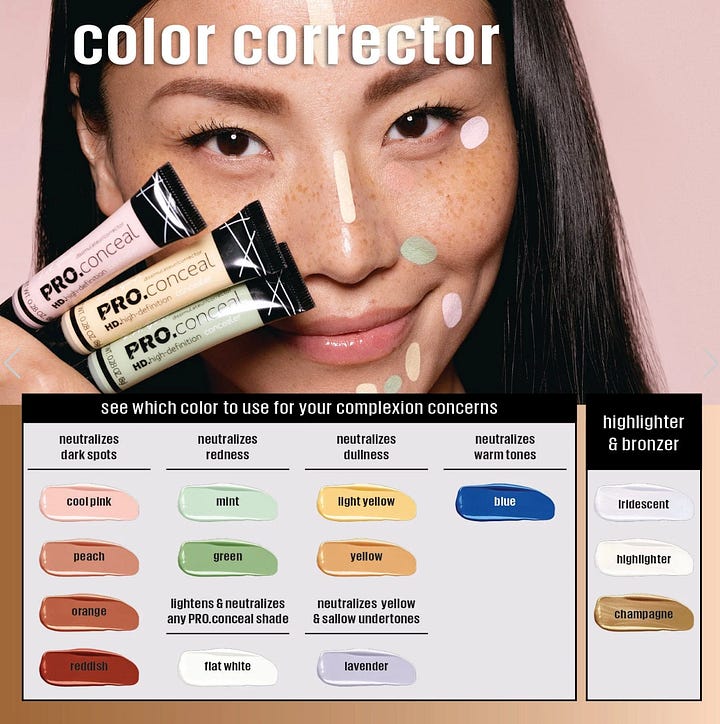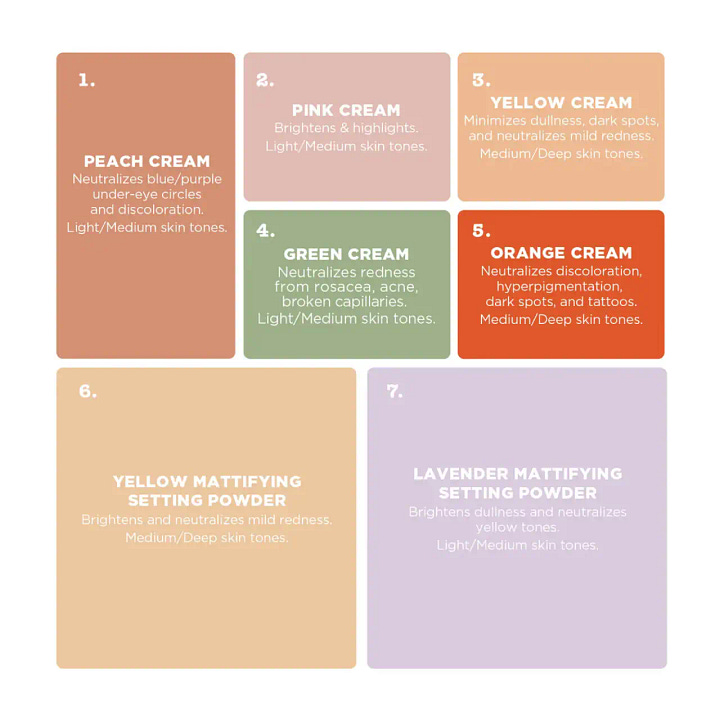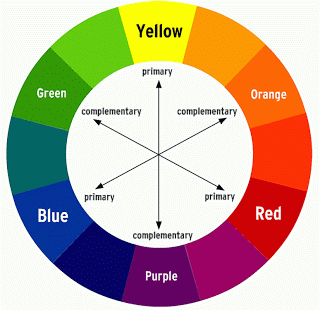Pigments With Benefits: Color Correctors
color theory basics & dark circle solutions
Hiya!
Today I’m going to tell you about a makeup product that has revolutionized my under eyes, but first we’re going back to art class.
Don’t forget, you have until tonight to enter the Jordan Samuel Skin giveaway and can continue to get 20% off all of his products through the end of April.
Also, yesterday both a Stylevana order (shipped from Hong Kong) and an Olive Young order (shipped from South Korea) arrived at my apartment after going through customs with no issues. Idk how and I’m not questioning it, but maybe you’ll be fine too!
COLOR CORRECTING 101
What is color correcting vs. concealing? If you’ve ever used a concealer/foundation and still saw some discoloration coming through or felt that it made your skin look grey/ashy, you may benefit from a color corrector. While a concealer/foundation is a shade matched to your skin tone*, your face has many different shades and depths of color, which is tricky for one shade of concealer to perfectly cover. True to their names, concealers conceal or cover imperfections, while a color corrector corrects the unwanted pigment. They work together to even out your complexion.
*This is why you match foundation to your neck color, which is more even than the face. Your foundation is meant to create a base on your face that matches your neck. When you are swatching foundation, stripe on the jawline and bring it down into the neck. The color that disappears is the correct one. (This logic is generally true for concealers as well, but in some cases you may want to choose a shade lighter for brightening…or use a color corrector 😉)
How do color correctors work? Color correcting helps to neutralize/cancel out discoloration by using color theory. Think about art class and complementary colors. Complementary colors are on opposite sides of the color wheel. When you combine them, they create a white or black, effectively neutralizing or canceling them out.
Do you need to use a color corrector? No. Your concealer may work just fine!
Can I use just a color corrector and not concealer? Sure, why not! If it works for you, go for it. But traditionally they are used with concealer/foundation for the most even-toned base.
How do you use color correctors? It depends on the area and how much coverage you want. Like with everything in makeup, there aren’t any rules, but there are best practices that can help. The most important thing to remember is that you only want to use a very small amount of color corrector, directly on the areas you are trying to correct.
If you want a more full coverage finish, you’d apply color corrector first, directly on the areas you’re trying to neutralize. Blend it in by stippling (vs. blending outward) to keep the color corrector on the targeted area. Let it dry for a minute or so (or set it with powder), then apply your concealer/foundation on top and blend it all together as you normally would.
If you want a more natural finish or are spot concealing, you can mix a tiny bit of color corrector with your concealer, which will adjust the concealer color just slightly. You can do this on the back of your hand, a mixing palette, or, as you’ll see in my example below, dab a bit of both on the area and blend together.
DARK CIRCLES & COLOR CORRECTORS
Dark circles can be caused by many things, often working together to drive you extra crazy and make you look like you’ve never slept in your life. Many of these reasons are out of your control (genetics, bone structure, veins), but all of them are difficult to treat.
My under eyes have always been a problem area. The area under my eyes is fairly hollow and you can see the blood pool underneath. I have a very visible vein running up the inner corner of my right eye, which makes that area extra dark, made worse by my orbital bone that casts a shadow over the whole thing. Plus, I’m not a great sleeper and I have a terrible habit of rubbing my eyes. The result is an eye area that’s varying shades of reddish/purple/blue. Fun! Truthfully, I don’t dislike it completely–my skin is so pale that I like some of the dimension it adds. But only some.
For much of my makeup-wearing life, I have encountered under eye color correctors in various shades of peachy/orange, meant to cancel out blue/purple tones. This certainly helped a lot! I relied on the Ole Henrikesen Banana Bright Eye Crème, a cult-favorite peachy-yellow toned eye cream that helps to neutralize discoloration immediately and overtime. I could wear it solo, or top it off with my beloved NARS Radiant Creamy Concealer. I didn’t think much of it until Kosas launched their Revealer Extra Bright Serum-Powered Color Corrector in 5 shades. The lightest, for very light to light skin tones… is pink.
I was confused by this recommendation, but after doing some research, I discovered that I had it all wrong. While peach can work to neutralize dark circles for most skin tones to an extent, it’s a better shade match for light-medium skin tones, especially those with warm undertones. Light skin tones (especially neutral-cool undertones, like myself) are better off using cooler-toned pink, which helps to neutralize and brighten, while deep to rich skin tones should use something more red leaning to help brighten and cancel out deeper blue/green discoloration. Here’s a helpful reel I found showing the difference between peach and pink.
At this point all of the lightbulbs in my head started going off and I felt very silly for not realizing this earlier because I was familiar with the Live Tinted Hue Sticks and also generally very good at understanding undertones and color theory. For some reason, I had been singularly focused on “orange cancels blue” instead of also taking into account skin tone and undertone. When I started bringing this up to some friends, I learned that I was not alone in this faulty thinking. Is it fair to blame Ole? Probably not, but I don’t think he’s fully absolved.
Anyway, I waited for the Sephora Sale to order the Kosas in pink and my under eyes will never be the same. It’s not that the Banana Bright looked bad, but the pink just looks better! It’s more brightening and natural. The brand says to apply the color corrector first, but I have preferred applying a dot closer to my inner eye, with a bit of my NARS concealer next to it. With my fingers or a brush, I start blending together, first towards the inside to concentrate the color correction where it’s darkest, and then bringing it outwards with the excess.
The Kosas is specifically designed for under eyes, so the shade range is specific to dark circle discoloration, ranging from pink to peach to red. It’s creamy, blendable, long-wearing and doesn’t crease or cake. Remember, you really just need to use a tiiiiiiny bit. I’m sure you could use it for color correction on other areas of the face, but below are some other color correctors that might be more suitable and some tips to get you started.
PICKING A COLOR CORRECTOR
Here’s the basic theory based on the color wheel:
Orange cancels out blue
Yellow cancels out purple
Green cancels out red
(and vice versa for all)
So while that logic works for all skin tones to an extent, you’ll have superior results when you adjust for your skin tone and undertone. Duh! (this duh! is directed at me)
Green cancels out intense redness (rosacea, breakouts, broken capillaries) on all skin tones, but best for light-medium skin, especially cool-toned.
Yellow cancels out purple tones (veins, bruises, dark circles, old hyperpigmentation), but can also help with mild redness and brighten dull skin. Best for light skin with warmer tones, olive skin, medium-deep skin.
Pink cancels out blueish tones (under eyes, some dark spots) on cooler-toned, fair-light skin.
Orange/peach cancels out blueish tones on warmer skin tones, and can work for light-medium-deep skin tones depending on the shade and severity of discoloration.
Deeper orange/red cancels out blueish, dark pigmentation (under eyes, dark spots) on deep-rich skin tones.
Lavender/purple brightens sallowness on lighter/cool toned skin and can cancel out yellow undertones (and bruises) on light-tan-medium skin, depending on the shade.
**Something important I want to note is that there is not universal agreement about which skin tones are best suited for each color corrector, as it depends on your skin tone and undertone, the undertone/intensity of the color corrector and the intensity of the pigment you are trying to correct. So use what I wrote as a guideline, but not a steadfast rule.


COLOR CORRECTOR RECOMMENDATIONS
Like other complexion products, color correctors come in liquids, creams, sticks and powders. You can also find palettes that have multiple color correctors in one.
Liquids
Kosas Revealer Extra Bright Serum-Powered Color Corrector (also at Sephora, but pink sold out)
L.A. Girl Pro Conceal HD (brush tip applicator)
Sticks (good for easy, precise application)
NYX Pro Fix It Color Correcting Concealer - comes in 24 shades (also at Ulta, but the NYX site has very helpful charts to help you find best match)
Live Tinted Hue Stick (also at Ulta)
Skincare/Primer/Makeup Hybrids
Dr. Jart+ Cicapair Tiger Grass Color Correcting Treatment - the very popular one you’ve probably seen. Green to beige, sort of like foundation, good for large red areas.
Make Up Forever Step 1 Color Correcting Primers (some colors at Sephora)
Creams & Palettes
NYX Color Correcting Concealer Palette (also at Ulta)
Make Up Forever Ultra HD Underpainting Color Correction Palette


Finally, if you really want to learn about color theory, here’s a very in-depth explainer from professional makeup brand Kryolan.
Office Hours Reminder
Join us for Office Hours on Sunday! This exclusive weekly opportunity is available to paying subscribers.
Every Sunday at 5pm EST, I’ll begin a new thread for the week in Substack Chat, where you can ask me anything. Every Monday from 5-6pm EST, I’ll be in that chat live, answering questions for the hour. That way, if you can’t make it, you can submit any time after 5pm Sunday and still get an answer. If you can make it live, join in! You can ask questions in real time and (hopefully) interact with others in class ;)
Have a great week!
xx,
Jolie






I had an Olive Young order arrive yesterday with no problems, too. And it got here in only 4 days!
I have the kosas corrector in peach. It's so great.